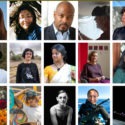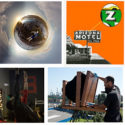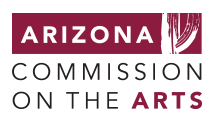Welcome to the first installment of Inside the App, a weekly five-part series designed to walk prospective applicants through the Artist Research and Development Grant application and outline some general principles of effective grant writing for artists.
Introduction
The Artist Research and Development Grant (ARDG) is the Arts Commission’s most competitive funding program and the only one directed specifically at supporting the work of individual artists. ARDGs are available to practicing artists working in all disciplines and at all stages in their careers and creative development. In the past, ARDGs have been awarded to some of Arizona’s most established and experienced artists, but also to emerging artists just entering the field.
The competition is fierce and the application is demanding, but if you’re creating strong, original work that impacts both your own artistic practice and the broader community (however you might define it), then you have a shot.
But, you’re going to need a strong application.
Over the course of five installments, Inside the App will guide you through the application, one section at a time. Along the way, we’ll provide insights from experts and past ARDG recipients. Follow along, draft your own application as you go, and by the end of this series you’ll be ready to submit a truly competitive application.
Ready to start?
“It’s so fine and yet so terrible to stand in front of a blank canvas.”
Paul Cezanne
“People are always asking me how long this piece took [to make], and my answer is that it took 45 years.”
P.Nosa
Every artist is intimately familiar with the “fine and terrible” feeling of facing a blank canvas in one form or another. Where does one begin? For 2015 ARDG recipient P.Nosa, every piece begins long before he approaches the canvas (or, in his case, a scrap of muslin). For Nosa, every work is built on the foundation of a lifetime’s accumulation of knowledge and exprerience.
Similarly, the process of grantwriting begins long before the first keystroke.
Step 1: Research
A thorough reading of the grant guidelines is absolutely essential to crafting a superior grant application.
This may seem obvious, but each year 5-10% of ARDG applications don’t make it to review because the applicant failed to follow the instructions or meet the basic eligibility requirements. It may seem like nitpicking, but in a highly competitive program, even the smallest details count.
Before you go any further, open the grant guidelines document and answer the following questions:
- What is the purpose of this grant? What sorts of projects does it support? Is my project a good fit?
- Do I meet the eligibility requirements?
- Does my project fit within the funding and timeline constraints?
Depending on your personal process and where you are in the development of your work, you may not be able to answer all of these questions right away. If you decide you want to pursue this grant, you may determine you need to reconsider your conception of the project or your mode of working. If your project isn’t a perfect fit, is there a component of it that could be?
These are very personal questions only you can answer, but if you’re unsure and want to talk it through with someone, you may want to contact the primary staff contact for ARDGs, Gabriela Muñoz. (Just make sure you’ve thoroughly reviewed the guidelines first and have specific questions about how to proceed. Vague and underdeveloped questions get vague and underdeveloped answers.)
“The hardest part is trying to get the work I do to fit into the grant proposal’s guidelines. I start by really trying to understand what [the funders] want from the proposal. I then try to make links to the work that I do and then shape a proposal that hits all the notes they are looking for.”
Alex! Jimenez
Alex! Jimenez had only been a practicing artist for a couple of years and had never received an institutional grant when she applied for (and received) a 2015 ARDG, but her application is one that we frequently use in workshops as a model of effective grantwriting. Her proposal demonstrates not only a strong understanding of her own objectives as an artist, but also those of the Arizona Commission on the Arts as they relate to the ARDG program.
Our grant guidelines always open with a statement of purpose. They also outline the criteria that will be used to evaluate a proposal’s alignment with that purpose. If your research begins and ends with the grant guidelines, you should have all the information you need, but for additional insight (and advantage) you may want to dig a little deeper. Consider the following:
What other resources does the funder offer? Do they offer guidance or instruction beyond the guidelines, such as online or in-person information sessions, samples of funded applications, or one-on-one consultation?
What is the larger context of this grant program? Funders develop grant programs in service of a larger mission. Understanding who the funder is and what their ultimate goals are can help you better understand the intent of the grant for which you are applying, and by extension, how to frame your proposal within that context.
What is the history of the grant? What sorts of artists and projects have been awarded in the past? How do past grantees talk about their work, particularly the project that received funding? Are past grantee’s proposals available for review?
Your assignment this week:
- Review the grant guidelines.
- Register for our upcoming online information session.
- Get to know some of our past ARDG recipients.
Related


34 Arizona Artists Awarded Research & Development Grants
Awarded through a competitive application and review process, these $5,000 grants support Arizona artists as they work to advance their artistic practice, expand their creative horizons, and deepen the impact of their work.
Read more
30 Arizona artists awarded Research & Development Grants
The Arizona Commission on the Arts awards 2022 Research & Development (R&D) Grants to 30 Arizona artists to advance their artistic practice, expand their creative horizons, and deepen the impact of their work.
Read more
Arizona Commission on the Arts and Arizona Community Foundation Announce Partnership, Additional Investments in Arizona Artists
On September 18, 2018, The Arizona Community Foundation (ACF) and the Arizona Commission on the Arts announced a joint effort to support Arizona artists, including additional funding from the recently established Newton and Betty Rosenzweig Fund for the Arts, an endowment held at ACF.
Read more
Perspectives: Danielle Foushée
Perspectives is an on ongoing series of interviews and check-ins with recipients of our Artist Research and Development Grant (ARDG). Recently, we spoke with Phoenix-based public artist Danielle Foushée about "Invitation," a piece installed at the entrance to Tempe Beach Park in October 2017.
Read more








